
Hours of Idleness was the first volume of poetry published by Lord Byron, in 1807, when he was 19 years old. [1] It is a collection of mostly short poems, many in imitation of classic Roman poets.

Hours of Idleness was the first volume of poetry published by Lord Byron, in 1807, when he was 19 years old. [1] It is a collection of mostly short poems, many in imitation of classic Roman poets.
The volume was published in June–July 1807 as a small octavo, printed and published by S. and J. Ridge of Newark in the UK and sold by the London booksellers: Crosby and Co.; Longman, Hurst, Rees, and Orme; F. and C. Rivington; and J, Mawman. The full title was Hours of Idleness; a Series of Poems Original and Translated. By George Gordon, Lord Byron, a Minor. It consisted of 187 pages with thirty-nine poems. Of these, nineteen came from the original Fugitive Pieces volume, while eight had first appeared in Poems on Various Occasions. Twelve were published for the first time. The "Fragment of a Translation from the 9th Book of Virgil's Aeneid" was included as "The Episode of Nisus and Euryalus, A Paraphrase from the Æneid, Lib. 9", made up of 406 lines.
After a scathing review in The Edinburgh Review in 1808, Byron responded by publishing, anonymously, his satiric poem English Bards and Scotch Reviewers in 1809. [2]
Critic Henry Brougham, 1st Baron Brougham and Vaux wrote of the volume: "The poesy of this young lord belongs to the class which neither gods nor men are said to permit." He attacked the poems as "effusions ... spread over a dead flat" like "so much stagnant water" and accused Byron of being disingenuous, "pleading his minority" while seeming at the same time to say, "See how a minor can write!"
In a letter to John Cam Hobhouse, Byron wrote of his reaction: "As an author, I am cut to atoms by the E[dinburgh] Review, it is just out, and has completely demolished my little fabric of fame."
The original manuscript was in the collections of Wisbech & Fenland Museum, Isle of Ely. [3]

Robert Southey was an English poet of the Romantic school, and Poet Laureate from 1813 until his death. Like the other Lake Poets, William Wordsworth and Samuel Taylor Coleridge, Southey began as a radical but became steadily more conservative as he gained respect for Britain and its institutions. Other romantics such as Byron accused him of siding with the establishment for money and status. He is remembered especially for the poem "After Blenheim" and the original version of "Goldilocks and the Three Bears".

Lady Caroline Lamb was an Anglo-Irish aristocrat and novelist, best known for Glenarvon, a Gothic novel. In 1812, she had an affair with Lord Byron, whom she described as "mad, bad, and dangerous to know". Her husband was the Honourable William Lamb, who after her death became 2nd Viscount Melbourne and British prime minister.

James Henry Leigh Hunt, best known as Leigh Hunt, was an English critic, essayist and poet.
This article contains information about the literary events and publications of 1816.

Gordon Randall Phillip David Garrett was an American science fiction and fantasy author. He was a contributor to Astounding and other science fiction magazines of the 1950s and 1960s. He instructed Robert Silverberg in the techniques of selling large quantities of action-adventure science fiction, and collaborated with him on two novels about men from Earth disrupting a peaceful agrarian civilization on an alien planet.
This is a chronology of events in the life of George Gordon Byron, 6th Baron Byron. Each year links to its corresponding "year in poetry" article:

The Corsair (1814) is a long tale in verse written by Lord Byron and published by John Murray in London. It was extremely popular, selling ten thousand copies on its first day of sale, and was influential throughout the following century, inspiring operas, music and ballet. The 180-page work was dedicated to Irish poet Thomas Moore.

Childe Harold's Pilgrimage is a long narrative poem in four parts written by Lord Byron. The poem was published between 1812 and 1818. Dedicated to "Ianthe", it describes the travels and reflections of a young man disillusioned with a life of pleasure and revelry and looking for distraction in foreign lands. In a wider sense, it is an expression of the melancholy and disillusionment felt by a generation weary of the wars of the post-Revolutionary and Napoleonic eras. The title comes from the term childe, a medieval title for a young man who was a candidate for knighthood.
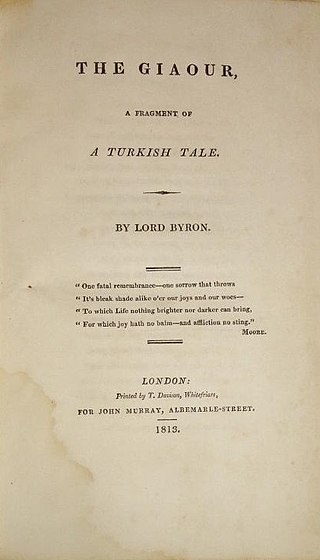
The Giaour is a poem by Lord Byron first published in 1813 by John Murray and printed by Thomas Davison. It was the first in the series of Byron's Oriental romances. The Giaour proved to be a great success when published, consolidating Byron's reputation critically and commercially.
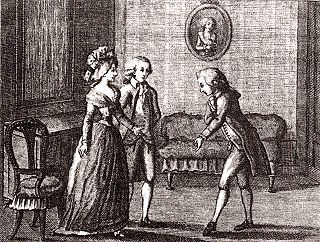
In 18th- and 19th-century Italy, the cicisbeo or cavalier servente was the man who was the professed gallant or lover of a woman married to someone else. With the knowledge and consent of the husband, the cicisbeo attended his mistress at public entertainments, to church and other occasions, and had privileged access to this woman. The arrangement is comparable to the Spanish cortejo or estrecho and, to a lesser degree, to the French petit-maître. The exact etymology of the word is unknown; some evidence suggests it originally meant "in a whisper". Other accounts suggest it is an inversion of bel cece, which means "beautiful chick (pea)". According to the Oxford English Dictionary, the first recorded usage of the term in English was found in a letter by Lady Mary Wortley Montagu dated 1718. The term appears in Italian in Giovanni Maria Muti's Quaresimale Del Padre Maestro Fra Giovanni Maria Muti De Predicatori of 1708.
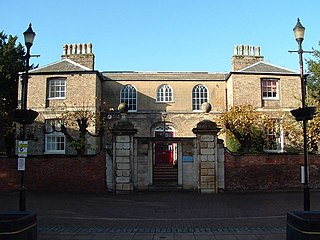
Wisbech Castle was a stone to motte-and-bailey castle built to fortify Wisbech on the orders of William I in 1072, it probably replaced an earlier timber and turf complex. The layout was probably oval in shape and size, on the line still marked by the Circus. The original design and layout is unknown. It was rebuilt in stone in 1087. The castle was reputedly destroyed in a flood in 1236. In the 15th century, repairs were becoming too much for the ageing structure, and a new building was started in 1478 under John Morton, Bishop of Ely. His successor, John Alcock, extended and completed the re-building and died in the Castle in 1500. Subsequent bishops also spent considerable sums on this new palace. The Bishop's Palace was built of brick with dressings of Ketton Stone, but its exact location is unknown.
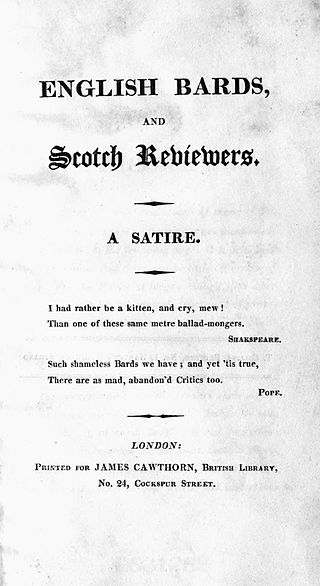
English Bards and Scotch Reviewers is an 1809 satirical poem written by Lord Byron, and published by James Cawthorn in London.
Nationality words link to articles with information on the nation's poetry or literature.
Nationality words link to articles with information on the nation's poetry or literature.

Hebrew Melodies is a collection of 30 poems by Lord Byron. They were largely created by Byron to accompany music composed by Isaac Nathan, who played the poet melodies which he claimed (incorrectly) dated back to the service of the Temple in Jerusalem.

George Gordon Byron, 6th Baron Byron was an English poet and peer. He is one of the major figures of the Romantic movement, and is regarded as being among the greatest of English poets. Among his best-known works are the lengthy narratives Don Juan and Childe Harold's Pilgrimage; much of his shorter lyrics in Hebrew Melodies also became popular.
The Eneados is a translation into Middle Scots of Virgil's Latin Aeneid, completed by the poet and clergyman Gavin Douglas in 1513.

The Wisbech & Fenland Museum, located in the town of Wisbech in the Isle of Ely, Cambridgeshire, England, is one of the oldest purpose-built museums in the United Kingdom. The museum logo is W&F.
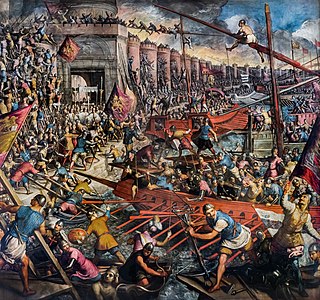
The Siege of Corinth is a rhymed, tragic narrative poem by Lord Byron. Published in 1816 by John Murray in London with the poem Parisina, it was inspired by the Ottoman massacre of the Venetian garrison holding the Acrocorinth in 1715 – an incident in the Ottoman reconquest of the Morea during the Ottoman-Venetian Wars.

Poems, in Two Volumes is a collection of poetry by English Romantic poet William Wordsworth, published in 1807.